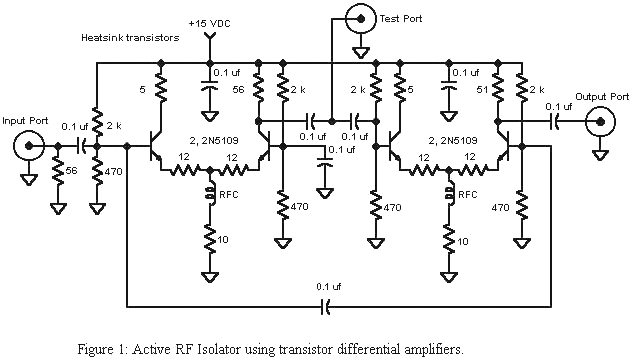
|
|
||
|
\главная\р.л. конструкции\... |
RF Isolator Uses Differential Amplifiers
An RF isolator is a seemingly magic device that allows signals to pass in only one direction. Signals applied to the input port are sent to the test port and signals coming into the test port can only go to the output port. This one-way property is usually accomplished with special non-linear ferrite/magnet structures operating at very high frequencies. Fig. 1 shows an active RF isolator capable of handling signals approaching 16 dBm and frequencies from well below 1 MHz to above 200 MHz. The circuit really emulates an isolator in that the actual signal energy is not passed from port to port and the signal levels must be fairly low. The circuit is well suited for testing the SWR of a variety of devices connected to the test port.

For a typical setup the test generator is connected to the input port, the antenna or device to be tested is connected to the test port, and a signal level monitor is connected to the output port. When the test port is terminated with 50 ohms, no energy is reflected and no signal will appear at the output port. If the load at the test port is not 50 ohms then some of the test signal will reflect and appear at the output port. For example, if the test port is completely open, the test signal reflects completely and the output will equal the input. If the test port is shorted, the test signal will reflect inverted and the output will be an inverted version of the input. Other loads will reflect a portion of the test signal.
To measure the return loss of a device or antenna,
first open or short the test port and observe the signal level at the output
port. Then connect the device to be tested and observe the drop in signal level
at the test port. The amount of drop is the return loss. This test may be done
in the presence of other signals if a tuned meter or spectrum analyzer is used
to monitor the test signal. Adjust the test signal frequency until it is sufficiently
far from the other signals to easily measure and verify that the other signals
present are not too large for the circuit to handle (below 16 dBm).
The transistors will run hot so use a low-capacitance heat sink. Increase the
10 ohm resistors in the emitter circuits to reduce the transistor heating but
the large signal handling ability will be reduced. The isolator is a 50 ohm
device due to the resistors near 50 ohms. (The 56 ohms are a bit higher since
they are shunted by some circuit resistance.) Other impedance like 75 ohms may
be achieved by changing these resistors to, say, 75 and 82 ohms. Ordinary small-signal
transistors like the 2N3904 operating at much lower current make a useful device
for testing antennas and low power devices at lower frequencies - perhaps to
50 MHz. Try 2, 82 ohms instead of the 2, 10 ohms in the emitters. Remember that
the signal handling capability will be quite low so use signals at or below
0 dBm (1 mW).
Some points for the experimenter to ponder:
Original document from http://www.wenzel.com/documents/circtran.htm